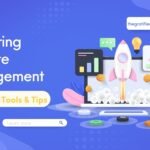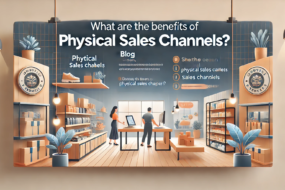
When it comes to driving business growth, understanding the difference between inside sales and outside sales is crucial. Both sales strategies play significant roles but differ in execution, approach, and outcomes. Inside sales, often conducted remotely, leverages technology to reach potential customers. Conversely, outside sales involve direct, face-to-face interactions, requiring sales representatives to travel and meet clients in person.
In this blog, we’ll dive into the key differences between inside sales vs outside sales, explore their unique characteristics, advantages, challenges and help you determine which approach best suits your business needs. Gaining insights into these two distinct sales methods will empower you to make informed decisions and boost your sales performance.
What Is Inside Sales?
Definition
Inside sales refers to sales conducted remotely, often using phone calls, emails, and online communication methods instead of face-to-face meetings. Inside sales representatives work from an office or home, using technology to reach and engage potential customers.
Characteristics
- Remote Communication: Inside sales rely heavily on technology. Sales reps interact with clients through phones, emails, video calls, and CRM tools.
- High Volume of Leads: Inside sales teams handle a large number of leads, focusing on quick, efficient communication.
- Shorter Sales Cycle: The process is generally faster compared to outside sales because there’s no travel involved.
- Data-Driven: Inside sales teams often use data analytics to track performance and optimise their strategies.
- Team Collaboration: Inside sales usually involve close collaboration with marketing and other departments to ensure a seamless sales process.
Advantages
- Cost-Effective: Without the need for travel, inside sales significantly reduce costs related to transportation and accommodation.
- Scalability: Companies can quickly scale their sales teams and reach more prospects without geographical constraints.
- Better Use of Technology: Inside sales teams leverage advanced technologies, like CRM systems, sales automation tools, and analytics, to improve efficiency and effectiveness.
- Increased Productivity: Sales reps can handle more leads and close deals faster, leading to higher productivity.
- Easier Training and Supervision: Managers can easily train and monitor inside sales reps since they work in the same location.
Challenges
- Building Relationships: It can be harder to build strong relationships without face-to-face interaction. Sales reps need excellent communication skills to establish trust over the phone or email.
- Competition for Attention: With many companies using similar outreach methods, standing out can be difficult. Prospects receive numerous sales calls and emails daily.
- Technology Dependence: Reliance on technology means that any technical issues or downtime can severely impact productivity.
- Motivation and Morale: Working remotely or in a call centre environment can be isolating and monotonous, leading to potential burnout or lack of motivation.
- Complex Sales: For high-ticket or complex sales, inside sales might struggle to convey the value proposition and close deals compared to in-person interactions.
Inside sales are vital to many businesses, offering a cost-effective and scalable way to reach and convert prospects. By leveraging technology and focusing on efficient communication, inside sales teams can achieve high productivity and quick sales cycles. With the right approach, inside sales can be a powerful tool for business growth.
What Is Outside Sales?
Definition
Outside sales, also known as field sales, involves sales representatives meeting clients face-to-face outside of the office. Unlike inside sales, where communication happens over the phone or via email, outside sales reps travel to meet potential customers, build relationships, and close deals in person.
Characteristics
- Personal Interaction: Outside sales focus on personal interactions. Sales reps visit clients at their offices, homes, or public places, allowing for direct communication and relationship building.
- Travel-Intensive: Reps often spend a lot of time travelling, whether it’s within a local area or across different regions. This travel is essential for meeting clients and prospects.
- Flexible Schedule: Outside sales reps typically have a flexible schedule. They arrange their meetings according to clients’ availability, which can lead to irregular working hours.
- High Touch: These roles require a high level of engagement and personalised service. Reps often engage in face-to-face meetings, presentations, and demos to persuade potential clients.
- Target-Oriented: Like all sales roles, outside sales are target-driven. Reps usually have specific quotas to meet and their performance is often evaluated based on their ability to achieve these goals.
Advantages
- Stronger Relationships: Face-to-face meetings help in building stronger, more personal relationships with clients. This can lead to higher trust and loyalty.
- Better Understanding of Client Needs: Meeting clients in their environment provides better insights into their needs and challenges, allowing reps to tailor their pitches more effectively.
- Higher Close Rates: The personal touch and direct interaction can lead to higher close rates compared to inside sales. Clients may feel more confident and persuaded by in-person meetings.
- Brand Representation: Reps act as the face of the company, providing a personal touch that can enhance the company’s image and reputation.
- Opportunity for Demos: Outside sales provide opportunities for live demonstrations of products or services, which can be more convincing than remote presentations.
Challenges
- High Costs: Travel expenses can be significant. Companies must cover costs for transportation, accommodation, and meals, which can add up quickly.
- Time-Consuming: Travel takes time. Reps might spend a large portion of their working hours commuting, which can reduce the time available for meeting clients and closing deals.
- Scheduling Conflicts: Arranging meetings that fit both the rep’s and the client’s schedules can be challenging, leading to potential delays in the sales process.
- Burnout Risk: The demanding nature of the job, with constant travel and irregular hours, can lead to burnout. Reps need to manage their time and health carefully.
- Limited Reach: Outside sales reps can only meet a limited number of clients in a given period due to travel constraints, unlike inside sales reps, who can make numerous calls or emails at the same time.
Outside sales play a crucial role in many industries. The personal interaction and relationship-building aspects can lead to stronger client connections and higher close rates. Understanding outside sales can help businesses optimise their sales strategies and improve overall performance.
Comparison: Inside Sales vs Outside Sales
When evaluating the effectiveness of inside sales vs outside sales, it’s important to consider various factors that influence cost, efficiency, reach, relationship building, and the sales cycle. Both methods have their unique advantages and can be integral to a comprehensive sales strategy. Below are some key points of comparison, along with additional aspects to consider.
Cost and Efficiency
- Inside Sales: Inside sales are generally more cost-effective due to lower travel expenses. Sales representatives can work from a single location, minimising costs related to transportation, accommodation, and other travel-related expenses.
- Outside Sales: Outside sales involve higher costs but can lead to higher-value deals. The face-to-face nature of outside sales often results in more substantial and lucrative contracts.
Reach and Volume
- Inside Sales: Inside sales allow for a higher volume of interactions. Reps can make more calls and send more emails in a day than they could physically meet clients. This high volume of outreach can lead to more opportunities and faster scaling.
- Outside Sales: Outside sales have a lower volume but can focus on quality over quantity. Personal meetings can yield more in-depth discussions and stronger connections with potential clients.
Relationship Building
- Inside Sales: Inside sales rely on building relationships through digital communication. This can be effective but may lack the personal touch that comes with face-to-face interactions.
- Outside Sales: Outside sales excel in building strong, personal relationships through face-to-face meetings. The ability to meet in person can foster trust and a deeper connection.
Sales Cycle
- Inside Sales: Inside sales often have a shorter sales cycle due to the ability to quickly reach out and follow up with many prospects. The efficiency of digital communication streamlines the process.
- Outside Sales: Outside sales tend to have longer cycles, given the need for travel and scheduling. However, in-person meetings can sometimes accelerate decision-making once the relationship is established.
Flexibility and Adaptability
- Inside Sales: Inside sales teams can quickly adapt to changing market conditions and client needs due to the ease of remote communication. This flexibility allows for rapid adjustments to sales strategies.
- Outside Sales: Outside sales require more coordination and planning, making it less flexible in quickly changing scenarios. However, the personal touch can be more persuasive in navigating complex negotiations.
Market Penetration
- Inside Sales: Inside sales can efficiently penetrate global markets without the need for a physical presence. This approach is ideal for reaching a broad audience quickly.
- Outside Sales: Outside sales are better suited for penetrating local markets where face-to-face interaction is valued. This method can be particularly effective in regions where personal relationships are critical to business success.
Training and Development
- Inside Sales: Training for inside sales often focuses on mastering digital tools and communication techniques. Continuous learning is supported by readily available online resources.
- Outside Sales: Training for outside sales emphasises presentation skills, travel logistics, and in-person negotiation tactics. Field experience is crucial for developing effective outside sales strategies.
Performance Metrics
- Inside Sales: Performance in inside sales is often measured by the number of calls made, emails sent, and virtual meetings held. Metrics are easily traceable through CRM systems.
- Outside Sales: Performance in outside sales is evaluated based on meetings conducted, deals closed, and revenue generated. Success often hinges on the quality of personal interactions.
Customer Insights
- Inside Sales: Inside sales teams gather customer insights primarily through digital interactions, surveys, and data analytics. This approach provides valuable data but may miss nuanced feedback.
- Outside Sales: Outside sales teams gain insights directly from face-to-face conversations, allowing for a deeper understanding of customer needs and preferences. This first-hand feedback can inform product development and sales strategies.
Both inside and outside sales have distinct advantages and challenges. Inside sales offer cost efficiency, higher volume, and flexibility, making it ideal for reaching a wide audience quickly. On the other hand, outside sales excel in building strong relationships, closing high-value deals, and gaining deep customer insights. An effective sales strategy often integrates both approaches, leveraging the strengths of each to maximise overall sales performance.
Integrating Inside and Outside Sales
Many businesses find that a hybrid approach, combining inside and outside sales, works best. This strategy leverages the strengths of both methods and mitigates their weaknesses.
Benefits of a Hybrid Approach:
- Flexibility: Allows businesses to adapt their approach based on the client’s preferences and the nature of the deal.
- Comprehensive Coverage: Maximises reach by using inside sales for initial contact and outside sales for closing larger deals.
- Balanced Costs: Reduces travel expenses by handling initial stages remotely and reserving face-to-face meetings for critical negotiations.
- Enhanced Relationships: Builds relationships through both frequent digital communication and personal interactions.
Case Studies
Case Study 1: Tech Startup
A tech startup focusing on SaaS products initially adopted an inside sales approach to reach a broad audience quickly. They used digital marketing and automated email campaigns to generate leads. However, they noticed that larger clients preferred in-person demonstrations and meetings. By integrating outside sales, they could close bigger deals, resulting in significant growth.
Case Study 2: Manufacturing Company
A manufacturing company traditionally relied on outside sales to sell their machinery. Sales representatives travelled extensively to meet potential clients and demonstrate their products. As the company expanded, travel costs became unsustainable. By incorporating inside sales for lead generation and initial contact, they reduced costs and improved efficiency, reserving outside sales for final negotiations and product demonstrations.
Tools and Technologies
For Inside Sales:
- CRM Software: Tools like Salesforce or HubSpot help manage and track sales activities.
- Email Marketing: Platforms like Mailchimp or Constant Contact facilitate automated email campaigns.
- Video Conferencing: Tools like Zoom or Microsoft Teams enable virtual meetings.
- Sales Automation: Solutions like Outreach or SalesLoft streamline repetitive tasks and improve productivity.
For Outside Sales:
- Mobile CRM: Apps like Zoho CRM or Pipedrive allow sales reps to manage activities on the go.
- GPS and Mapping: Tools like Google Maps or Waze help plan and optimize travel routes.
- Presentation Software: Tools like PowerPoint or Prezi enable engaging product demonstrations.
- Scheduling Tools: Platforms like Calendly or Doodle facilitate meeting coordination.
Future Trends
Inside Sales Trends:
- Increased Use of AI and Automation: AI tools will continue to enhance lead generation and customer relationship management, making sales processes more efficient.
- Remote Work: The shift to remote work is likely to continue, with sales teams using virtual meetings and collaboration tools to engage with clients.
- Data-Driven Sales Strategies: More companies will leverage data analytics to understand customer behaviour and tailor their sales strategies accordingly.
- Personalization at Scale: With advanced CRM systems, inside sales teams can provide highly personalised experiences to a larger audience.
- Enhanced Training Programs: Continuous learning through virtual training sessions and AI-driven coaching will become the norm to keep sales teams sharp.
Outside Sales Trends:
- Hybrid Sales Roles: The line between inside and outside sales will blur, with salespeople needing to adapt to both in-person and virtual selling environments.
- Focus on Relationship Building: Building strong, long-term relationships with clients will be more important than ever, with a focus on trust and personalised service.
- Mobile Technology: Sales professionals will rely heavily on mobile apps and tools to manage their tasks and communicate with clients on the go.
- In-Person Meetings for Key Deals: While virtual meetings are here to stay, critical negotiations and high-stakes deals will still often require face-to-face interaction.
- Sustainability and Social Responsibility: Companies will prioritise sustainable practices and social responsibility, with sales teams highlighting these aspects during client interactions.
Conclusion
Both inside sales and outside sales have unique strengths and challenges. The choice between them depends on various factors, including the nature of the product or service, target audience, and budget. By understanding the differences and benefits of each approach, businesses can develop a sales strategy that best suits their needs.
A hybrid approach often provides the best of both worlds, combining the efficiency and cost-effectiveness of inside sales with the personal touch and relationship-building strengths of outside sales. As technology continues to evolve, the lines between inside and outside sales may blur further, creating new opportunities for innovative sales strategies.
Whether you choose inside sales, outside sales, or a combination of both, the key to success lies in understanding your customers, leveraging the right tools, and continuously adapting to market changes. By doing so, businesses can build strong relationships, close more deals, and achieve long-term success in an ever-competitive market.








No Comments